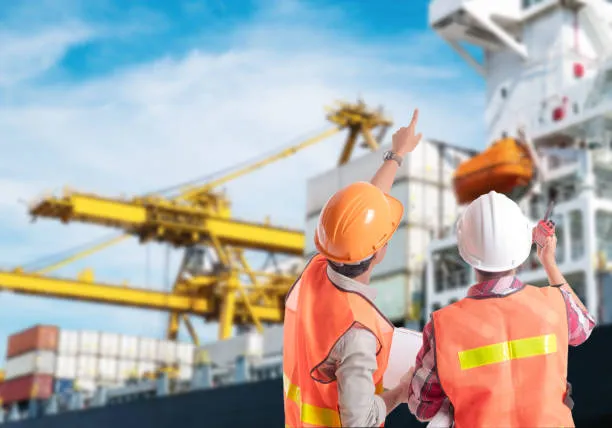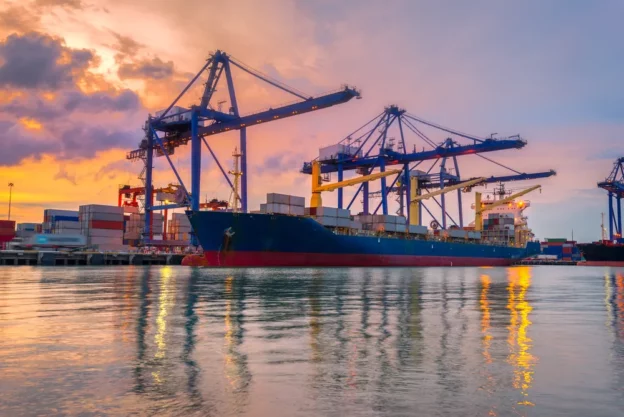Table of Contents
Introduction
Security in maritime terminals refers to the comprehensive protection of vessels, both inside and outside, covering aspects related to national defense, economic development, the preservation of the marine environment and the protection of human life. Areas under surveillance and protection include oceans, territorial waters, regional seas, rivers and ports. Maritime security strategies aim to monitor and respond to crimes such as piracy, illicit trafficking in people and goods, illegal fishing, marine pollution and acts of armed violence on the high seas.
The European Union Maritime Security Strategy (EUMSS) constitutes a comprehensive EU action plan to address the various challenges in the global maritime sphere that may impact individuals, activities or infrastructure in the EU territory.
Among the interests protected by the EUMSS are:
- Security and general peace.
- Rule of law and freedom of navigation.
- Border control.
- Maritime infrastructure: ports and terminals, coastal protection, submarine cables and pipelines. marine platforms and scientific equipment.
- Shared natural resources and environmental health.
- Adaptation to climate change.
Description of operational maritime security technologies
In the current context of the 21st century, maritime security requires the advanced and effective use of information technologies (IT) and operational technologies (OT) on board ships.
The convergence of digital and communication technologies has enabled the integration of IT and OT environments, leading to the development of maritime systems such as the Vessel Integrated Navigation System (VINS).
This system combines information from multiple navigation aids to provide accurate and reliable data on the position, speed and attitude of the vessel, thus ensuring its safe operation.
VINS represents a significant advance in improving maritime safety, offering results superior to those obtained by individual navigation aid components.
The global positioning system (GPS) has revolutionized global maritime navigation operations by providing an accurate and fast path for navigation, speed measurement and location determination.
This impact extends to safety and efficiency in maritime navigation, as well as improving situational awareness of commercial vessels and their cargo for governments and stakeholders. GPS has significantly transformed maritime navigation procedures and has had an impact on improving safety and efficiency in this area.

Satellite communications in maritime security
High-speed satellite communications keep vessels connected to shore, providing global reach through terrestrial and satellite technologies. In the field of maritime safety, these communications allow the crew to make distress calls and transmit priority messages in critical situations, such as storms or collisions, through satellite communication networks.
AIS is an automated tracking system that shows the location of other nearby vessels, allowing the automatic electronic exchange of nautical information between vessels and coastal facilities using transponders on board vessels.
Radar, essential for tracking vessels, operates by emitting a radio signal that is reflected when an object hits. Although AIS vessel tracking has been a significant advance in maritime security, it does not replace, but rather complements, radar systems for maritime surveillance.
The electronic chart display and information system (ECDIS) facilitates location and navigation, with automatic route planning, monitoring and ETA calculation capabilities, interacting with other equipment such as radar and GPS.

Security in maritime terminals: A technical approach
Efficient management of marine terminals depends on robust security strategies to safeguard these facilities. The security of ships, both internally and externally, represents a crucial aspect of maritime security, addressing issues related to national security, economic development, human security and environmental concerns in the marine environment.
Strategies in this context seek to detect and respond to criminal activities such as piracy, illegal trafficking of people and goods, illegal fishing, marine pollution and acts of armed robbery at sea.
The European Union Maritime Security Strategy (EUMSS) exemplifies a joint EU plan aimed at addressing global maritime challenges that may impact people, activities or infrastructure.
In the 21st century maritime context, it is essential that maritime security leverages advanced and effective information technologies (IT) and operational technologies (OT) on board vessels. The convergence of digital and communication technologies has led to the integration of the IT and OT fields, giving rise to the creation of maritime systems such as the Vessel Integrated Navigation System.
It is essential to develop and preserve safe and efficient maritime terminals, which are facilities intended for the loading and unloading of goods, passengers or fuel. These terminals play a critical role in global trade, transportation and energy supply, and their design and maintenance require a comprehensive approach encompassing engineering, environmental, operational and safety considerations.
Therefore, the implementation of comprehensive security strategies is crucial for the effective and safe management of maritime terminals.
Risk prevention in maritime terminals
The International Maritime Organization ( IMO ) has been a driving force in mitigating risks at sea through the implementation of specific regulatory measures.
The International Convention for the Safety of Life at Sea, 1974 (SOLAS), in its most recent revisions, stands out as the IMO’s main legal framework for addressing a wide range of risks associated with the safe operation of ships.
Within SOLAS, three preeminent risks are identified and closely examined: Structural integrity , fire risk and navigation risks.
These risks have been selected based on a comprehensive statistical analysis of previous maritime incidents, where navigation risk, in particular, has been shown to be associated with the highest number of accidents.
The measures proposed in SOLAS and its complementary codes not only operate synergistically, but have also proven to be significant contributions to safeguarding the safety of personnel, protecting the marine environment and preserving property involved in maritime navigation.
Arnaud, cited by Ale, Burnap and Slater (2015), has conceptualized risk as the combination of two essential elements: The probability of occurrence and the result of an event. Furthermore, safety is commonly defined as the absence of unacceptable risks (Hollnagel, 2016).
The management of risks associated with maritime operations is a fundamental pillar to ensure the safeguarding of life at sea, this being the primary objective outlined in SOLAS 1974, clearly reflected in the introduction of its provisions.
Risks do not exist in isolation, but are often interconnected. When an incident is triggered due to a specific primary risk, the subsequent sequence of events may trigger the manifestation of a secondary risk. For example, a navigation hazard resulting from a collision can also result in structural damage.

Risk assessment in maritime terminals
Risks do not exist in isolation, but are often interconnected. When an incident is triggered due to a specific primary risk, the subsequent sequence of events may trigger the manifestation of a secondary risk. For example, a navigation hazard resulting from a collision can also result in structural damage.
In the current context of the maritime industry, ensuring safety involves facing significant complexity due to the diversity of aspects that must be reviewed, as well as the multiple possibilities of safety violations that can occur.
Security managers must be alert not only to possible attempts to violate laws and national security, but also to local and internal threats. Even small-scale attacks can have a significant negative impact on a maritime business, causing loss of life, severe environmental damage, or damage to business property. These represent some of the most significant risks.
During the transportation of valuable goods and resources, there may be local attempts to steal these goods from the vessels. Security managers must therefore maintain constant vigilance both in ports and on the high seas to ensure the protection of valuable and highly sensitive cargo.
Maritime security tactics
Maritime security officers, especially Vessel Security Officers (VSOs), implement a number of daily best practices to prevent incidents:
- Regular vessel inspections: Periodic checks are carried out to actively monitor and ensure compliance with safety measures, detecting any anomaly or atypical situation.
- Maintenance supervision to optimize safety: The VSO’s responsibility involves the supervision and proper care of any element on board that is not aligned with safety standards, ensuring its correction and appropriate maintenance.
- Cargo coordination and management: During loading and unloading operations, the VSO ensures that established protocols are followed, carrying out exhaustive controls and supervising the inspection of ships’ warehouses and holds.
- Proposals for modifications: If possible improvements are identified in the vessel’s security plan, it is the responsibility of the VSO to suggest them to the company’s security officer, thus contributing to the implementation of comprehensive changes to strengthen security.
- Reporting Problems: If a vessel inspection reveals any irregularities, the VSO must immediately inform the company safety officer so that corrective action can be implemented immediately and effectively.
Ensuring security awareness and vigilance does not only fall to the Vessel Security Officer (VSO), but involves the collaboration of the entire crew to identify any anomalies. The safety officer has the responsibility of motivating the crew to remain alert and report possible risks.
Rigorous supervision of security equipment, including operations, testing and maintenance, is a direct responsibility of the security officer.
Additionally, the safety officer must supervise and support the crew’s adherence to current safety protocols and regulations on the vessel.

Conclusion
Large-scale security measures involve events with international reach, often arising from more deliberate operations than individual crimes. This covers aspects such as terrorism, environmental crimes, smuggling and illicit trafficking, representing more global threats in the maritime field.
The advancement of telecommunications and international trade logistics has expanded opportunities for terrorists, who often attempt to use sea routes to transport weapons and dangerous materials.
These groups use maritime transport to promote their objectives, becoming a threat to global, political and economic security, as well as to the safety of citizens. It is therefore crucial that maritime professionals take comprehensive measures to safeguard vessels and protect their countries from these potential threats.
International crimes persist and maritime security plays a key role in mitigating its spread. The ability of the shipping industry to intercept illegal shipments at their origin translates into a reduction in the negative impact that these shipments could cause by preventing the arrival of illegal products and weapons into the hands of criminals.
Given the magnitude of the containers carried by each ship, it is challenging for security to thoroughly examine each container. Criminals are aware of this difficulty and take advantage of it to their advantage, attempting to circumvent the security measures implemented by the shipping industry due to its vastness and scale, making it a susceptible target.
As for future threats in the maritime industry, it is evident that it is constantly evolving. With increasing automation and technological advances, a transformation in security standards is expected that will require continuous adaptation.
The advances and improvements implemented in the maritime industry focus on solving the problem of visibility in the supply chain. As technology and controls progress, security officers will be able to identify and secure weak points in the shipping process to ensure vessel safety.
With the increasing sophistication of hackers, cyber attacks against operational technology systems on ships are expected to become more common. This underlines the need for a comprehensive assessment of all operational aspects of vessels in the maritime industry to ensure adequate protection against these increasing threats.
References
- https://up42.com/blog/an-overview-of-maritime-and-port-security.
- www.usaid.gov/sites/default/files/2022-05/Maritime-Security-Sector-Reform_FINAL.pdf
- https://www.mitags.org/security-guide/
- https://www.linkedin.com/advice/0/how-do-you-design-maintain-safe-ficient-marine

